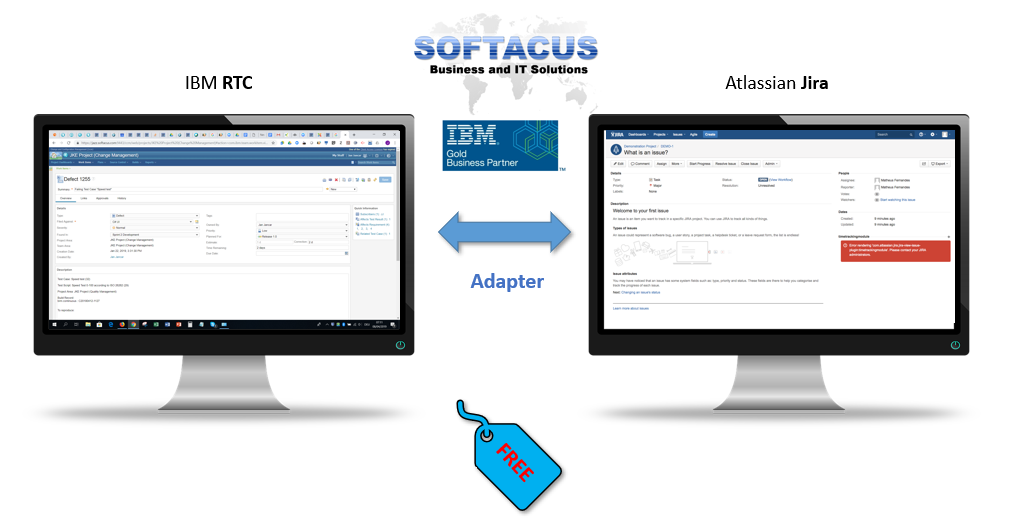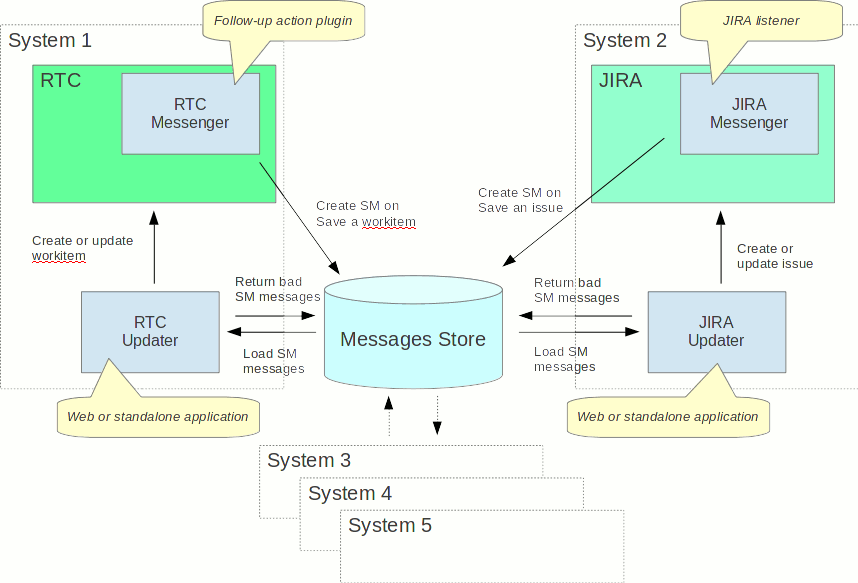Overview
EWM/JIRA Integration Adapter is multi-component software that provides on-fly synchronization of data between IBM Engineering Workflow Management and Atlassian JIRA systems. The solution is very flexible and can be adapted for almost any system with out-of-the-box or custom realizations.

The data exchange is based on the exchange by sync messages. The source system produces such messages as a result of user actions and the integrated system imports the messages making necessary data transformations and updates within. EWM/JIRA Integration Adapter is software that brings data exchange capabilities to the systems.
You can integrate systems in a one-to-many way. The simplest case when two systems can be synchronized. As well as a single system can be synchronized with several others when any data change will be processed for one or for a number of linked systems.
Features
Main features put into the foundation of EWM/JIRA Integration Adapter:
Real-Time Processing
It means that any changes are distributed between the systems as soon as possible. If a user creates from scratch or changes existing data in the system on any side where the integration software works then sync messages are being produced. After a sync message was created, it will go to another system and processed without any additional delays. Of course, this principle will be ensured only if both systems work properly and there are no constraints implied to data channels.
Flexibility
EWM/JIRA Integration Adapter is a very flexible solution. You can adapt it to almost any environment. In practice, different systems can be integrated with each other. You can configure either bi-directional or uni-directional data exchange.
The systems can work with diverse types of data and fields and define various workflows with many states of data. To provide synchronization between so different data stores, you have to define transformation rules for describing the desired updates of data (in another word, you will specify which data and how must be updated to be correctly transferred into other systems). Transformation rules can be easily enhanced if the integrated systems were improved or customized.
Offline Synchronization
If any of the integrated systems is in offline mode then sync messages will be collected until the off system will start. But as soon the system starts again and operates properly, EWM/JIRA Integration Adapter will process the accumulated messages in the order of their receiving. It will ensure that all postponed changes from the first system will be correctly translated into the second one.
Scalability
EWM/JIRA Integration Adapter is an extensible solution because any complex integration can be assembled from separate software modules. Just analyze the targeted park of systems, identify the systems which you would like to synchronize, and deploy the required sync modules. If some modules are absent then develop them and include them in the integrating solution without rebuilding the existing ones.
Reliability
Failures in the synchronization process will not be crashed and will not result in losing the data. Not processed sync messages are collected separately and can be analyzed later for eventual decision-making and later processing if needed.
Easy Deployment
Deployment of EWM/JIRA Integration Adapter is very easy. Independence from third-party software is a very important principle realized for the integrating solution! You don't need to purchase and deploy any additional software designed, for example, for storage management, RDBMS, databases, etc.
Its modules can be installed either as stand-alone applications (only run them on the server with double-click like simple programs), or Apache Tomcat applications, or IBM WebSphere Application Server applications.
Architecture
EWM/JIRA Integration Adapter architecture is as simpler as possible. The solution has a modular structure enabling adapt it to almost any business environment for many customers. Modules may be combined with each other into a common solution. You can even create custom modules and add them to existing ones.

Sync message (the basic piece of sync data) is an XML file. Therefore, it's very easy to apply any additional processing for sync messages if needed. For example, you can additionally encrypt the sync messages with external tools, including third-party ones, and it will contribute to more safety in data transition.
EWM/JIRA Integration Adapter includes the next components:
- EWM Messenger is a special extension installed in Engineering Workflow Management and designed for the creation of sync messages after the user updates work items.
- EWM Updater is a software module whose main purpose is looking for sync messages incoming from JIRA, transforming them in accordance to defined synchronization rules, and sending the information about needed updates into Engineering Workflow Management.
- JIRA Messenger is a JIRA listener whose work is similar to EWM Messenger. In the same way, it's designed for the creation of sync messages after user changes in JIRA.
- JIRA Updater that looks for sync messages arrived from Engineering Workflow Management, transforms them into the respective format, and sends them into JIRA providing the necessary changes there.
The distinctive features of both EWM Updater and JIRA Updater are the realization of transformers within them. This need results from fact that synchronized systems has usually different architecture, data structure, and presentation of data pieces. In other words, you must analyze incoming data, transform the data for sending then into another system and make required modifications in the linked system. Transformers work in accordance with the synchronization rules, which are configured in the so-called transformation map. It's a simple XML file that fully describes all the synchronizing rules. For example, you can define transformations for field names (accordingly, the field names in the incoming sync messages will be converted as you need). In the simplest case, you can use primitive transformation maps if you want to synchronize identical systems (for example, one Engineering Workflow Management with another one realizing something like multisite structure).
The realized architecture permits postponed synchronization if needed. Sometimes, the systems can be unavailable some time, for example, as a result of routine maintenance. But later, when the system becomes active again, the collected messages are processed in the same sequence as they were received. Such an approach gives a great advantage in providing high reliability of data transition for sync data and avoiding any data losses.
EWM/JIRA Integration Adapter is a multi-platform solution because it's built entirely in Java. It permits deploy the modules in Windows, Linux, Unix, HP-UX, Solaris, macOS, and other environments.
Users can choose the way how to deploy integration modules. They can be stand-alone applications or applications for installation at many application servers (Apache Tomcat and IBM WebSphere Application Server are supported).
Advantages
EWM/JIRA Integration Adapter gives you the next business values:
- Organize the common information environment in the company involving individuals into effective business process controlled at various project levels.
- Reduce expenses when you can partially install open source systems or systems with licenses purchased for a small cost. You can distribute users between systems and realize effective data synchronization and get a significant economy.
- Reduce requirements to employee's skills because they need only be masters in one system among the integrated ones but not in all. If an employee added the data into a single system, EWM/JIRA Integration Adapter will automatically create or update the linked data in other systems.
- Increase productivity of employees because they don't need anymore jump between different systems, especially if the systems have various user interfaces resulting in time and money losses.
- Reduce the impact of human factors when reducing the routine operations if you must support duplicated data in various systems. You don't need to do it manually anymore.
- Higher security and safety when you need to integrate information systems in organizations with closed network segments. For example, they can be defense departments, banks, organizations with innovation activities (when you must prevent any information losses), etc. EWM/JIRA Integration Adapter is able to work with any kind of data transportation. You can deliver the sync messages even in a sealed briefcase or single flash carrier. It means that EWM/JIRA Integration Adapter doesn't require a direct connection between synchronized systems.
Constraints
- EWM/JIRA Integration Adapter is a very flexible solution and can synchronize almost any kind of system. But such flexibility results in the need for complex work when you deploy the solution. For example, qualified developers must be involved some time in building complex transformation maps.
- JIRA Cloud environment is not supported because JIRA listeners aren't supported there
Cost
This adapter is offered free of charge to customers which have purchased the IBM Rational Solution via Softacus for the period of active maintenance.
Softacus Services
We, in Softacus, are experts when it comes to consulting and service delivery of IBM software products and solutions in your business. We help our clients to improve visibility and transparency when licensing and managing commercial software, providing measurable value while increasing efficiency and accountability and we are providing services in different areas (see Softacus Services).
IBM ELM extensions developed by Softacus are free of charge for the customers who ordered IBM ELM licenses via Softacus or for the customers who ordered any of our services. If you are interested in any of our IBM ELM extensions, you found a bug or you have any enhancement request, please let us know at info@softacus.com.
Related and Referenced Topics
Blog Articles:
Basics of Links and Link Types in IBM DOORS Next Generation - learn the basics about the linking and link types in IBM DOORS Next.
Linking Techniques in IBM DOORS Next - article explaining basic concepts and showing multiple ways of creation of links between artifacts.
Link By Attribute Feature in IBM DOORS Next - the article explains how to use the "Link by attribute" function to automatically create, update, or delete one or more links between artifacts based on values in the attributes of the artifact.
Softacus Widgets:
Link Switcher - widget developed by Softacus, that converts the context of artifacts links in a very short time.
Module Link Statistics - extension that provides users with a quick overview of the amount of the links in specific link types in a module.
Link Type Change- extension developed by Softacus designed to enhance the functionality of DOORS Next Generation by allowing users to manipulate the direction of a link or convert it to another type of link.
Links Builder- extension that allows the users to create a link between two artifacts in DOORS Next Generation according to the certain rules.
Link by Foreign Attribute - this extension allows users to create links between artifacts in the selected module(s), based on the attributes values.
Show Attributes of Linked Artifacts - this extension shows the attributes and links of the artifact that is currently selected.








